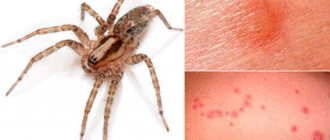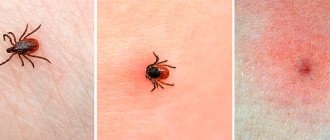Many people think that ticks can only bite a person or a dog, without posing a danger to the cat family. This is not true; according to statistics, cats suffer from tick bites and develop complications much less frequently, but the course of the disease, diagnosis and treatment are more difficult. Even domestic cats require special attention, since the parasite can enter the house through shoes or on human clothing.
Ticks are especially active from March to November; they can be found in grass or bushes, in city parks, and forests. Parasites pose a danger to walking animals, but even if the animal does not leave the house or apartment, the risk of finding a parasite in a cat is not so small.
What to do if your cat is bitten by a tick
If a cat is bitten by a tick, it is necessary to determine its type, of which there are more than 1000: dust ticks, ear ticks, scabies, etc. Ixodid ticks are considered the most dangerous for cats, as they are carriers of pathogens of many diseases.
It is necessary to examine the surface of the skin to determine the extent of its penetration. It is advisable if a specialist removes the parasite, since there is a risk of leaving part of the head under the skin. Also, when the insect moves strongly, the spread of infection increases.
Most often, bloodsuckers choose to bite the groin area, behind the hind legs, ears, stomach and armpit. An attached parasite is visible to the naked eye; immediately after detection, it is advisable to isolate the cat from children, take it to the veterinarian, or try to get rid of the insect yourself.
If a cat is bitten by a tick, then at this moment the animal does not experience pain or discomfort because upon penetration the parasite releases pain-relieving enzymes. Therefore, during the active months of parasite reproduction, you should regularly examine your cat; you can run a comb against the grain and feel the vulnerable spots.
Is this virus from the forest? Favorite habitats
The blood-sucking insect that infected our murka turned out to be a carrier of the most dangerous and even deadly infection - encephalitis!
It was first diagnosed in people in the 1930s in the Far East. And only in 1937, a group of scientists, under the leadership of the Soviet academic immunologist L.A. Zilber, isolated a virus from the Flavivirus genus.
They identified the carrier of a dangerous disease - the ixodid tick, which can parasitize wild animals. Squirrels, hedgehogs, wild boars, rats, mice, even birds contribute to the migration of the virus from the Far East to western Europe.
Blood-sucking parasites are a seasonal annual problem! From spring to late autumn, they like to be located in thick grass and low bushes, which means they can be everywhere: in parks, in the forest, in cemeteries, in urban forest belts. Their activity peaks in the hot months. But they can transmit their destructive infection at any time of the season to both people and pets!
Symptoms of a bite in cats
Symptoms of a tick bite in cats do not appear immediately after detection; the animal behaves calmly, has good appetite and sleep, and the cat does not feel pain, since the parasite uses pain-relieving enzymes during its introduction.
After it has been removed from the skin, it is necessary to monitor the condition of the pet. In case of infection and infection enters the bloodstream, the disease can begin to manifest itself only after a few weeks - the incubation period of infectious diseases.
Symptoms of a tick bite in a cat that should alert you:
- urine has turned pink;
- cough, heavy breathing;
- paleness of the nasal mucous membranes;
- vomiting, bowel dysfunction;
- signs of dehydration;
- sudden weight loss;
- loss of appetite or complete refusal;
- lethargy, lack of interest in the environment;
- heat.
If one or more symptoms occur, you should contact your veterinarian to preserve the health and life of your pet.
Consequences of a bite
Are ticks dangerous for cats? The parasite's bite itself does not threaten the health of the pet; the danger lies in the pathogens that can get from it to the animal through the bite. The Ixodid tick can cause the development of diseases such as piroplasmosis, hemorrhagic fever, typhus and encephalitis, and borreliosis.
If treatment is not started on time, the infection can affect many body systems and internal organs of your furry friend.
If a cat is bitten by a tick, the consequences, symptoms and treatment depend on the type of infection. Some diseases only affect the cat’s immune system, it becomes lethargic and apathetic, but treatment in this case is 95% effective. Other diseases may not respond to treatment and lead to the death of the pet.
What to do at home if you are bitten
If the bloodsucker has not burrowed into the pet’s skin and it is found on the fur or in the place where the cat sleeps, then it is necessary to inspect the skin. Using a comb, you need to comb the animal against the fur, push it apart with your hands and inspect the skin. Favorite places for parasites to invade are the armpits, hind legs, stomach and groin. If a bite is detected, it is necessary to treat the wound or take it to a veterinary hospital; you should monitor the cat’s health for several weeks; if deterioration occurs, you should consult a doctor.
You can get rid of the parasite as follows:
- Wear gloves on your hands, and upon completion of all manipulations, carefully perform hygiene.
- To prevent the infection from spreading faster, do not lubricate the area around the tick with oil.
- You should not pull the parasite, this will lead to further penetration of the insect's head and the spread of infection.
- The tick must be removed completely without damaging it.
- You can remove the insect using thread or tweezers. You should grab the body of the parasite and pull it out gently and without sudden movements.
- If, however, part of the tick’s head remains in the skin, there is no need to worry too much, since the cat’s body can independently reject the remaining body. This often leads to the development of a small abscess, which can be prevented by contacting a veterinarian.
Treatment is prescribed only by a veterinarian based on the test results and existing symptoms; usually, antibiotic therapy cannot be avoided. You are allowed to treat the bite site yourself at home using antiseptic drugs, with the exception of iodine and brilliant green.
Prohibited actions
You should not try to remove the pest yourself if you do not have the necessary tools or confidence that the procedure will go without complications.
It is prohibited to treat a parasite that has attached itself to the skin with alcohol, oil or any other similar substance.
This method is practiced in folk medicine. Theoretically, the use of this technique forces the tick to detach itself, because lubricating the insect with these agents will interfere with its breathing process (while feeding, the parasite breathes through spiracles located on its body). This method of removing arthropods is not considered effective and is not recognized by official medicine.
You should not pick off a tick or crush it while it is feeding. If the insect was removed by the pet owner, then you should make sure that the pest’s proboscis did not remain in the cat’s body. This part of the parasite may contain a dangerous virus.
You cannot ignore the symptoms of an animal’s disease, even if they appear a month after the bite, or try to treat the cat yourself. Incorrectly selected therapy or untimely provision of qualified assistance in most cases leads to death.
Ixodid ticks in cats
A tick bite that carries piroplasmosis or encephalitis does not pose a danger to a cat, but other more dangerous diseases can develop, such as theileriosis, tularemia and hemobartonellosis. Ixodid ticks are one of the most famous types of parasites, common in many climatic zones.
Symptoms and consequences have different characteristics - it all depends on the type of pathogen. Each disease has a distinctive clinical picture and incubation period:
- Hemobartonellosis. This infectious disease causes anemia only in cats; the disease is not dangerous for humans and dogs. The infection, spreading throughout the body, settles in the lymph nodes, bone marrow, liver and spleen. The incubation period ranges from several days to three weeks. The manifestation of symptoms depends on the animal’s immune defense; with weak immunity, the disease becomes severe. The disease manifests itself in decreased appetite, rapid heartbeat, lethargy and fading of the cat, the skin is pale or yellow, and the temperature is elevated. Only an urgent visit to the veterinarian can save the life of a pet.
- Tularemia. The pathogen enters the lymph nodes through the cat’s blood, developing a purulent inflammatory process. After some time, the lesions are opened, which leads to even greater blood infection. The disease affects the spleen, liver and lungs. Tularemia manifests itself in the form of lethargy of the animal, the skin becomes yellowish, small ulcerations form on the mucous surfaces, the lymph nodes in the neck are enlarged, the animal experiences malaise and fever. If treatment is not started in time, the cat dies in a matter of time, one of the causes of death is necrosis of the tissues of the spleen, lungs and liver. This disease is dangerous to humans and is transmitted through contact.
- Theileriosis. The infection, entering the animal's blood, multiplies in the spleen, lungs, liver and lymph nodes, causing severe damage. The first symptoms appear 1–3 weeks after the tick bite: the cat becomes lethargic, the temperature rises, the skin is yellow, the cat looks thin and apathetic, and the appetite disappears. Upon examination, the veterinarian notes an increase in internal organs. The disease is difficult for cats to tolerate, and only timely treatment can save the animal’s life.
To prevent such consequences after an ixodid tick bite, it is necessary to carry out prevention, constant examination of the animal and timely treatment.
Subcutaneous mites
Demodex or hair mites live in small numbers in the upper layers of the skin and follicles at the base of the hair in areas of minimal pubescence: head, paws, neck, areas around the eyes. Parasites feed on dead particles of the epidermis and can exist for many years without causing any harm to the animal.
Demodex was originally called the eyelash or eye mite, which parasitized livestock, and then moved on to pets and humans. This name was given because the parasites affect not only the skin, but also settle on the eyelashes near the eyes.
Signs of the disease appear only during the period of decreased immunity in the pet in the form of the following symptoms:
- the animal is nervous due to severe itching and constantly tries to scratch itself;
- in the affected areas, the coat becomes thin, and baldness is possible;
- Scratching until it bleeds, crusts, and blisters with pus appear on the skin.
Diseases caused by subcutaneous mites and their symptoms:
- Demodicosis - affects the upper layers of the skin, causing constant itching and allergic reactions, degeneration and scars on the surface of the epidermis.
- Cat scabies or notoedrosis - is manifested by the formation of ulcers on the skin and large fistulas that begin in the head area and then spread down the body, leading to severe itching and baldness. Ring mites can be transmitted to humans and other animals.
- Cheyletiellosis (walking dandruff) - looks like profuse dandruff with a mass of microscopic mites, the movement of which creates the impression of movement (hence the name). Its signs are scaly nodules on the skin of the back and hair loss. The disease is contagious to humans.
- Sarcoptic mange or pruritic scabies - appears first on the cat's face, then affecting the entire body, expressed in the formation of scabs and crusts, which is accompanied by unbearable itching. Sarcoptoid mites in cats are intradermal parasites; infection occurs through objects and through contact with sick animals.
Having determined the presence of subcutaneous mites by characteristic symptoms, treatment is carried out only after correct diagnosis and tests done in a veterinary clinic. Usually, scrapings of the affected epithelium are taken to accurately determine the type of parasite.
Treatment depends on the severity of the disease: milder forms often self-heal by improving the pet’s immunity after establishing proper nutrition and careful care.
If the disease is advanced, the following procedures are used to cure:
- Baths with keratological shampoos.
- They trim the hair in damaged areas, and then treat with acaricidal preparations: Fungin ointments and drops (cost of solution is 150-160 rubles, spray about 300 rubles), Iruksovetin (price 370-400 rubles), Saphroderm, Amitrazine.
- Bacterial complications must be treated with a course of antibiotics prescribed by a doctor.
- Vitamin preparations and supplements: Ligfol is a drug for stimulating regenerative processes in the body of animals, improving immunity, accelerating wound healing (price per 100 ml is about 1800 rubles).
- To treat fungal infections, Ivermectin is prescribed subcutaneously. The price of the medicine and its analogues depends on the volume of liquid for injection and ranges from 200 to 1500 rubles.
- It is imperative to treat all animals that have been in contact with the sick person.
- The quarantine of a sick cat lasts 30 days.
- The premises and care items are disinfected using an acaricidal drug (Delta Zone, etc.)
We invite you to familiarize yourself with Feline Leukemia. A story of life and love with cats with leukemia.: sestratk — LiveJournal
Can a tick fall off on its own from a cat?
Ticks and cats are a hot topic for the hot season, since it is in the summer that animals most often suffer from parasite bites. Having discovered a parasite attached to a pet, many people have a question: can the tick fall off on its own?
It is better not to wait until it detaches itself; it is necessary to remove the insect as soon as possible, since the longer the parasite is under the skin, the more infection will enter the blood. In some cases, when the tick is completely saturated with blood, it is able to fall off on its own.
Can a cat die from a tick bite?
Are ticks dangerous for cats? The parasite itself does not pose a danger to the animal if it is not the causative agent of any disease.
Can a cat die from a tick bite? With timely treatment and treatment, the animal’s health is restored without complications. If urgent measures are not taken, the animal’s body weakens in a matter of time, exhaustion and disruption of the functioning of internal organs are observed, which leads to serious consequences, including death.
Danger of ticks for cats
There is a myth among the population that ticks are only dangerous to people and dogs, while they are harmless to cats. This statement is erroneous. Pest bites are less likely to cause negative consequences in cats; their pathology is more difficult to diagnose, but parasites also pose a danger to these animals.
Not all insects can be harmful or fatal.
The most dangerous ones belong to the ixodid and argas groups. The threat is not the bite itself, but the infection that the pest can infect its victim with. Ticks can transmit diseases to animals such as:
- piroplasmosis;
- ehrlichiosis;
- hemobartonellosis (infectious anemia);
- theileriosis;
- encephalitis;
- borreliosis (Lyme disease), etc.
Are ticks on a cat dangerous for humans?
If it has already been saturated with cat blood, then it poses no danger to the human body. It is worth remembering that the parasite cannot infect a cat with encephalitis, while this disease is very dangerous for humans.
Having discovered a tick on an animal, it is possible that there may be several such parasites on the pet, in which case there is a risk that the insect will move onto a person’s skin and bite him. Therefore, it is important to examine your pet for parasites while wearing protective gloves.











